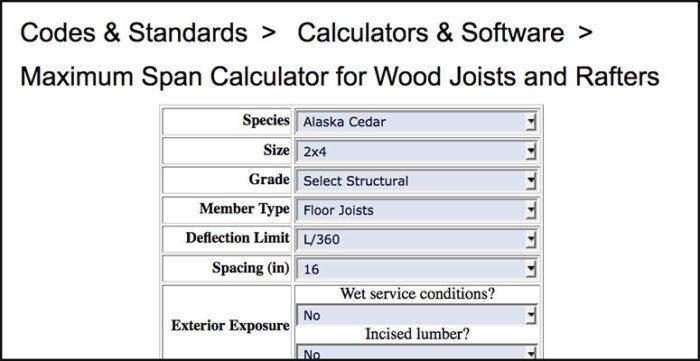Online Calculators Help Cover Deck-Load Requirements
Span tables don’t cover your deck load requirements? The American Wood Council has two handy online calculators that can handle a range of specifics.

One shortcoming of the span tables in the International Residential Code and the American Wood Council’s Prescriptive Residential Wood Deck Construction Guide (DCA 6) is that they’re limited to decks with a live load of 40 psf and a dead load of 10 psf. That means they won’t work for areas with heavier snow loads, for decks with heavy decking materials like stone, or in numerous other circumstances.
The American Wood Council’s online Maximum Span Calculator for Wood Joists and Rafters offers solutions. The calculator gives you the maximum span for a selected joist species, lumber grade, exterior exposure, on-center spacing, and live and dead loads. This is great when you are designing decks that fall outside the prescriptive limits of the DCA 6 and IRC tables.
Here’s a rundown of the entries:
- Species: there are about 30 choices including the primary species used for pressure treating.
- Size: 2×4 through 2×12
- Grade: there are numerous choices. The main choices for most decks will be #1 or #2 grades and for SYP there will be differing effective dates and density choices.
- Member Type: floor joist
- Deflection Limit: L/360 is the best choice and matches what the code tables are based on
- Spacing: choices for 12 in., 16 in., 19.2 in., and 24 in. on center.
- Exterior Exposure (two entries): Wet Service = Yes, Incised lumber = Yes for D-fir, hem-fir, SPF or No for SYP
- Live Load: 30 lb. to 100 lb. choices in 10 lb. increments
- Dead Load: 5 lb., 7 lb., 10 lb., 15 lb., and 20 lb.
When you click “Calculate Maximum Horizontal Span” at the bottom of the entries, the system will give you the maximum span for the information you’ve entered. Because the calculator goes beyond the limits of grade, live load, and dead load in the DCA 6 and IRC tables, you can design decks that fall outside the table limits. For instance, if you know the dead load of the deck will be less than the prescriptive 10 lb., then you can select 5 lb. or 7 lb. and eek out a longer span. On the other hand, if you build in a ground-snow load that exceeds 40 psf, then you can enter your snow load in the “Live Load” field to size a joist span to handle heavy snow.
The Span Options Calculator is useful if you already have a span designed and want to know what joist size you can use.
On this calculator, you enter everything the same as with the Maximum Span Calculator, except you include the feet and inch dimension of the deck and don’t enter the joist size or the grade. The result gives you options for lumber grade and joist size (depth). Some lumber yards stock #1 pressure-treated lumber in addition to or instead of #2. You may find it more cost effective to use a 2×10 #1 grade rather than a 2×12 #2 grade for a particular joist span.
You can also toggle between different on-center spacing and recalculate to see what different joist sizes options are available to you.
For more about getting your deck joists right and the joist-span tables in DCA 6 and the 2018 IRC, check out the article “Get Your Deck Joists Right” in FHB #274.
Fine Homebuilding Recommended Products
Fine Homebuilding receives a commission for items purchased through links on this site, including Amazon Associates and other affiliate advertising programs.

Anchor Bolt Marker

Standard Marking Chalk

Cepco BoWrench Decking Tool






View Comments
fantastic
Careful with these calculators or tables (coming from a structural engineer).
Many decks have joists that span from ledger to and over a beam, cantilevering a few feet past the beam. Unless the calculator or table SPECIFICALLY includes input for the cantilever portion, one must assume that it calculates for a simple, single span. Cantilevered joists present a whole new stress condition that the prescriptive tables (or calculators) do not take into account.